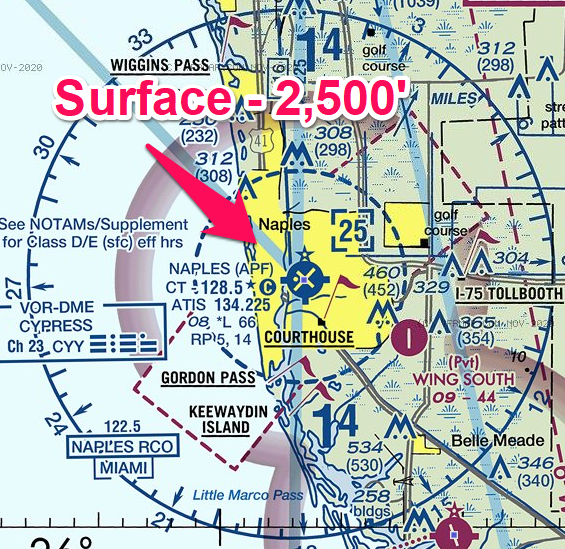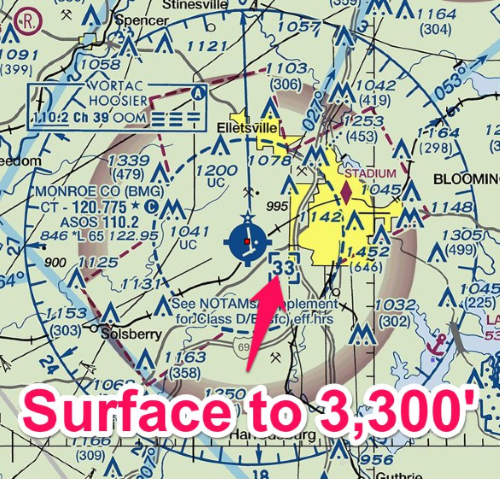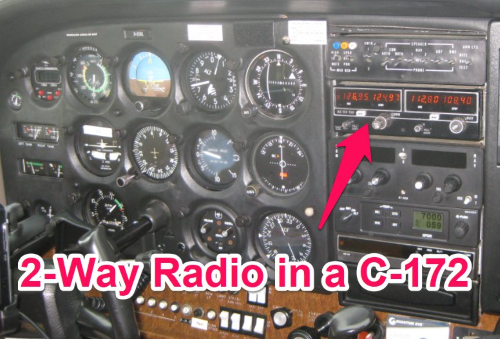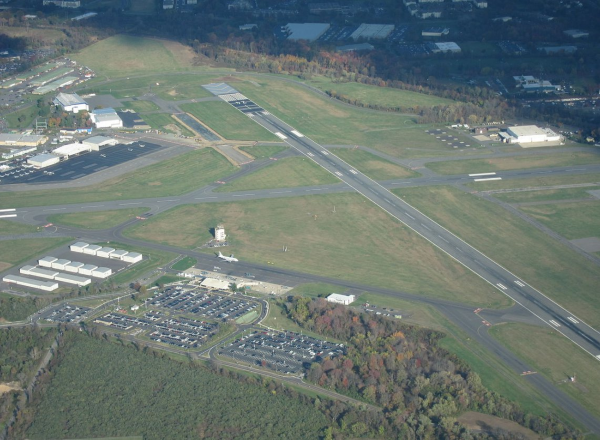There are several classes of airspace that require control, and Class D (Delta) airspace encompasses some of the smallest airports that require a control tower.
For pilots flying smaller General Aviation airplanes, Delta is the least intimidating controlled airspace to fly into.
Flight into an airport with an operating control tower is actually a requirement to be licensed.
But what exactly is Delta airspace, where is it located, and what are the rules for entry?
Keep reading to find out everything you wanted to know about Class D airspace!
1. What is Class D Airspace?

There are 5 classes of controlled airspace, and Class D (or Class Delta) is one of them.
In general, Class D airspace extends upwards from ground level to 2,500 above the airport elevation, with a radius of 4NM from the Class D airport.
Each Class D area is individually tailored, and normally contain instrument procedures for IFR landings.
A Class Delta airport has a control tower and provides weather reporting, but doesn’t provide radar services requiring a unique transponder squawk code.
To enter and operate in Delta airspace, two-way radio communication must be established and maintained.
On the sectional chart, Class D airspace is depicted in blue, with blue dashed lines surrounding the airspace.
The airport in the center of the airspace is also colored blue, and a pair of numbers in a box is nearby, indicating the height of the Delta airspace, in 100’s of feet MSL.

For instance, Monroe County Airport (KBMG) is a Class D airport with the numbers 33 nearby, indicating that the airspace extends to 3,300ft MSL.
If the Delta airspace is also below the shelf of Class C or B, a minus sign is in front of the numbers, indicating that a new class of airspace is above it.
KPWK airport in Palwaukee, IL is an example of this, as it exists below the shelf of the O’Hare Class B airspace, and is depicted on the chart with a [-30].
This means that the KPWK Class D extends from the ground up to 3,000ft MSL, and the Class B airspace is above that altitude.
Occasionally, there may be blue or magenta dashed boxes that are used as extension of the airspace for instrument approaches.
Some control towers have certain operating hours, and it is a pilot’s responsibility to verify operating hours before a flight.
Related Article – 8 Types of Special Use Airspace
2. Class D Airspace Weather & Visibility Requirements
All airspace below 18,000ft MSL has specific weather and visibility requirements to fly in.
For Delta Airspace, visibility must be at least 3 statute miles with a ceiling of at least 1,000ft AGL.
Cloud clearance requirements are 500ft below, 1,000ft above, and 2,000ft horizontally.
It is possible to fly below these minimums if a Special VFR (SVFR) clearance is requested.
This enables pilots to fly when the visibility is at least 1 statute mile and remain clear of clouds.
However, the tower cannot give a SVFR, it must be requested by the pilot.
3. Class D Equipment Requirements

The only equipment requirement to fly within Class D Airspace is a working two-way radio.
Two-way radio communication with the control tower/ATC must be established before entering Class Delta, and radio contact must be maintained while inside this airspace.
Unlike Class A, B, and C, a Mode C transponder is not required, as Class D airspace does not provide radar services to pilots.
4. Class Delta Pilot Requirements
There are no specific requirements for pilots to enter and fly within Delta Airspace.
Student pilots are allowed and encouraged to operate within Class D, as one of the requirements to get a Pilot’s License is for 3 takeoffs and landings at an airport with a working control tower.
Related Article – Class G Airspace Explained
Frequently Asked Questions (FAQ)
5. Do you need a clearance to enter Class D airspace?
Two-way radio communication is the only requirement to enter this type of airspace.
A pilot does not need to hear a specific clearance from the control tower to enter as long as the tower responds to a request with their tail number.
However, the Class D control tower can request that a pilot remains clear of the airspace until further instructed to enter.
6. Can you fly a drone in Class Delta airspace?
While in the past the answer was a definitive ‘NO’, in 2017 the FAA launched the LAANC (Low Altitude Authorization and Notification Capability) system.
The LAANC system is an app that drone users can use to apply for permission to fly within controlled airspace, such as Delta.
There is a limit to the number of airports that use the LAANC system, but it is available at 726 airports, so chances are good a nearby airport participates.
More information about the LAANC system is available on the Federal Aviation Administration website.
7. What is the speed limit in Cass D airspace?
The speed limit below 2,500ft AGL and within 4NM of the primary Class D airport is 200kts, unless specifically approved by ATC for a higher speed.
Conclusion
Class D Airspace surrounds the smallest airports with control towers, and only require two-way radio contact to enter.
Unlike other types of controlled airspace, a transponder is not required, and pilots of all types and ratings may operate within Delta Airspace.
In general, Class Delta airspace extends 2,500ft AGL above the airport, with a radius of 4NM.
Some airports may have different airspace layouts, or have airspace extensions to facilitate instrument traffic.
Within Class D Airspace, pilots must have 3SM visibility, and remain 500ft below, 1,000ft above, and 2,000ft horizontally of clouds.
Class D Airspace can be found on sectional charts highlighted in blue, with a pair of numbers inside the airspace near the airport indicating the ceiling of the airspace.
Sometimes, the end of Delta airspace is the beginning of other controlled airspace, like Class C and B.
This normally occurs when a Class D airport exists under the shelf of a larger airport.
Because Class Delta airports are smaller and have less requirements to enter, they are a great way for a novice pilot to gain experience talking with ATC.


